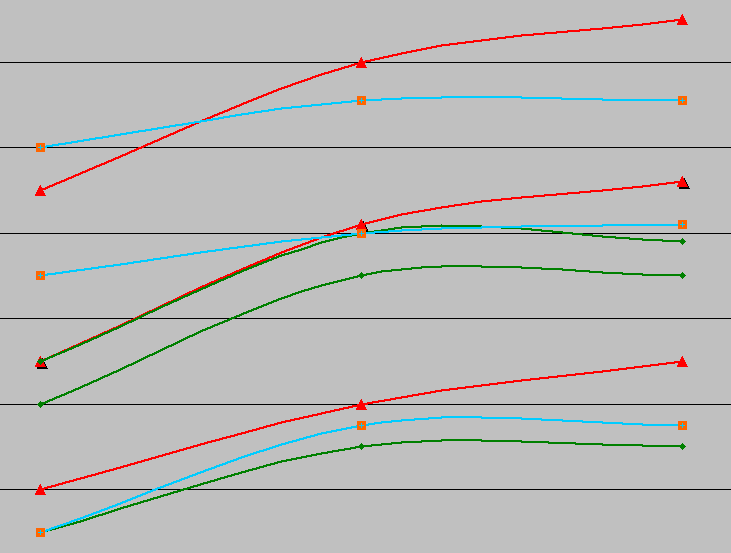Thanks to Corsair folks, I have the opportunity to take a pair of 2x2GB Corsair PC2-9136 Dominator (TWIN2X4096-9136C5DF) dual channel kit for a test drive



Rated Specifications:
- 2x 2048MB matched CM2X2048-9136C5D modules
- 571Mhz or DDR2-1142MHz 5-5-5-15 2T
- 2.1v
- SPD: JEDEC standard 5-5-5-18 values at 800MHz
- SPD: EPP standard 5-5-5-15, 2.1V values
The 4GB Corsair PC2-9136 Dominator kit was tested and validated in Corsair's labs using an eVGA 680i SLI nvidia chipset motherboard (P32 bios) and comes with the Corsair Dominator Airflow fan which consists of 3x40mm fans just like the Corsair Dominator PC2-10000C5DF kit.
Viewing Corsair's latest IC inquiry thread listing of ICs, most of Corsair's product lines have transitioned to PSC - powerchip ICs and the 4GB Corsair PC2-9136 Dominators are no exception
System specs
- Intel Core 2 Extreme QX9650 L739A640
- Thermalright Ultra 120 Extreme + 120x38mm Panaflo 103cfm (MX-2 TIM)
- DFI LP LT P38-T2R 1/11 Official bios
- 128MB Gainward FX5200 PCI
- 2x2GB Corsair PC2-9136C5DF Dominator dual channel kit (dimm 1+3 slots)
- 750GB Samsung HD753LJ
- Pioneer DVD-RW
- 620W Corsair HX620
- WinXP Pro SP2
Results:
Everest Ultimate SPD settings for modules - looks like week 12, 2008 made with a week 13 packaging date on module's Dominator heatsink label - 08130508 v1.1
I've started testing on DFI LT X38-T2R motherboard with 1/11 official bios and they overclock very easily just by setting memory to 571Mhz 5-5-5-15 and vdimm to 2.10v I was already booting and memtest86+ v2.01 stable!
@585Mhz 5-5-5-15 2.10v
Quick jump to 585Mhz 5-5-5-15 at 2.10v still was easily quad Super Pi 32M stable (hyperpi v0.99 gui wrapper) and single Super Pi 32M stable
click image for full screen shot.
CPUZ Validation
Quad Super Pi 32M
Single Super Pi 32M
Everest Ultimate Bandwidth
Memtest Windows stress test 4x 750MB
Code:DFI LP LT X38-T2R 1/11 Bios Settings PC Health Status Adjust CPU Temp: +6 CPU Feature - Thermal Management Control: Disabled - PPM(EIST) Mode: Disabled - Limit CPUID MaxVal: Disabled - CIE Function: Disabled - Execute Disable Bit: Disabled - Virtualization Technology: Disabled - Core Multi-Processing: Enabled Exist Setup Shutdown: Mode 2 Shutdown after AC Loss: Disabled CLOCK VC0 divider: AUTO CPU Clock Ratio Unlock: Enabled CPU Clock Ratio: 10x - Target CPU Clock: 3903 N/2 Ratio: Disabled CPU Clock: 390 Boot Up Clock: AUTO DRAM Speed: 266/800 - Target DRAM Speed: 1172 PCIE Clock: 100mhz PCIE Slot Config: 1X 1X CPU Spread Spectrum: Disabled PCIE Spread Spectrum: Disabled SATA Spread Spectrum: Disabled Voltage Settings CPU VID Control: 1.3000v CPU VID Special Add: AUTO DRAM Voltage Control: 2.10v SB Core/CPU PLL Voltage: 1.51 NB Core Voltage: 1.517 CPU VTT Voltage: 1.175 Vcore Droop Control: Enabled Clockgen Voltage Control: 3.45v GTL+ Buffers Strength: Strong Host Slew Rate: Weak GTL REF Voltage Control: Enable x CPU GTL1/3 REF Volt: 105 x CPU GTL 0/2 REF Volt: 97 x North Bridge GTL REF Volt: 82 DRAM Timing - Enhance Data transmitting: FAST - Enhance Addressing: AUTO - T2 Dispatch: Disabled Clock Setting Fine Delay Ch1 Clock Crossing Setting: More Aggressive - DIMM 1 Clock fine delay: 420 - DIMM 2 Clock fine delay: 560 - DIMM 1 Control fine delay: 630 - DIMM 2 Control fine delay: 490 - Ch 1 Command fine delay: 910 Ch2 Clock Crossing Setting: More Aggressive - DIMM 3 Clock fine delay: 420 - DIMM 4 Clock fine delay: 560 - DIMM 3 Control fine delay: 630 - DIMM 4 Control fine delay: 490 - Ch 2 Command fine delay: 910 Ch1Ch2 CommonClock Setting: More Aggressive Ch1 RDCAS GNT-Chip Delay: Auto Ch1 WRCAS GNT-Chip Delay: Auto Ch1 Command to CS Delay: Auto Ch2 RDCAS GNT-Chip Delay: Auto Ch2 WRCAS GNT-Chip Delay: Auto Ch2 Command to CS Delay: Auto (where cpuz sees 1T or 2T SETTING) CAS Latency Time (tCL): 5 RAS# to CAS# Delay (tRCD): 5 RAS# Precharge (tRP): 5 Precharge Delay (tRAS): 15 All Precharge to Act: Auto REF to ACT Delay (tRFC): 52 Performance LVL (Read Delay) (tRD): 6 Read delay phase adjust: Enter Ch1 Read delay phase (4~0) - Channel 1 Phase 0 Pull-In: Enabled - Channel 1 Phase 1 Pull-In: Enabled - Channel 1 Phase 2 Pull-In: Enabled - Channel 1 Phase 3 Pull-In: Enabled - Channel 1 Phase 4 Pull-In: Enabled Ch2 Read delay phase (4~0) - Channel 2 Phase 0 Pull-In: Enabled - Channel 2 Phase 1 Pull-In: Auto - Channel 2 Phase 2 Pull-In: Auto - Channel 2 Phase 3 Pull-In: Auto - Channel 2 Phase 4 Pull-In: Auto MCH ODT Latency: Auto Write to PRE Delay (tWR): 13 Rank Write to Read (tWTR): 11 ACT to ACT Delay (tRRD): Auto Read to Write Delay (tRDWR): Auto Ranks Write to Write (tWRWR): Auto Ranks Read to Read (tRDRD): Auto Ranks Write to Read (tWRRD): Auto Read CAS# Precharge (tRTP): Auto ALL PRE to Refresh: Auto












 Reply With Quote
Reply With Quote





 .
. 











 1240mhz@2.02v
1240mhz@2.02v  Yes, Yellowbeard, a tall rough man with a big yellow beard
Yes, Yellowbeard, a tall rough man with a big yellow beard

Bookmarks